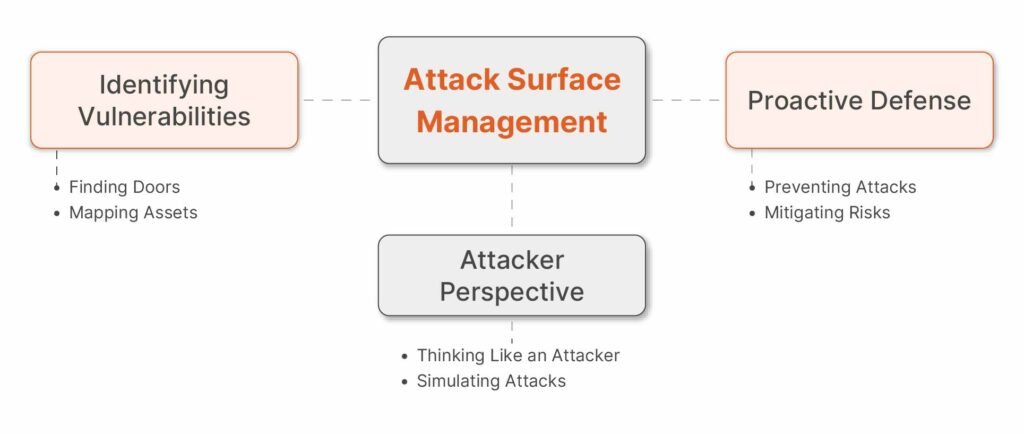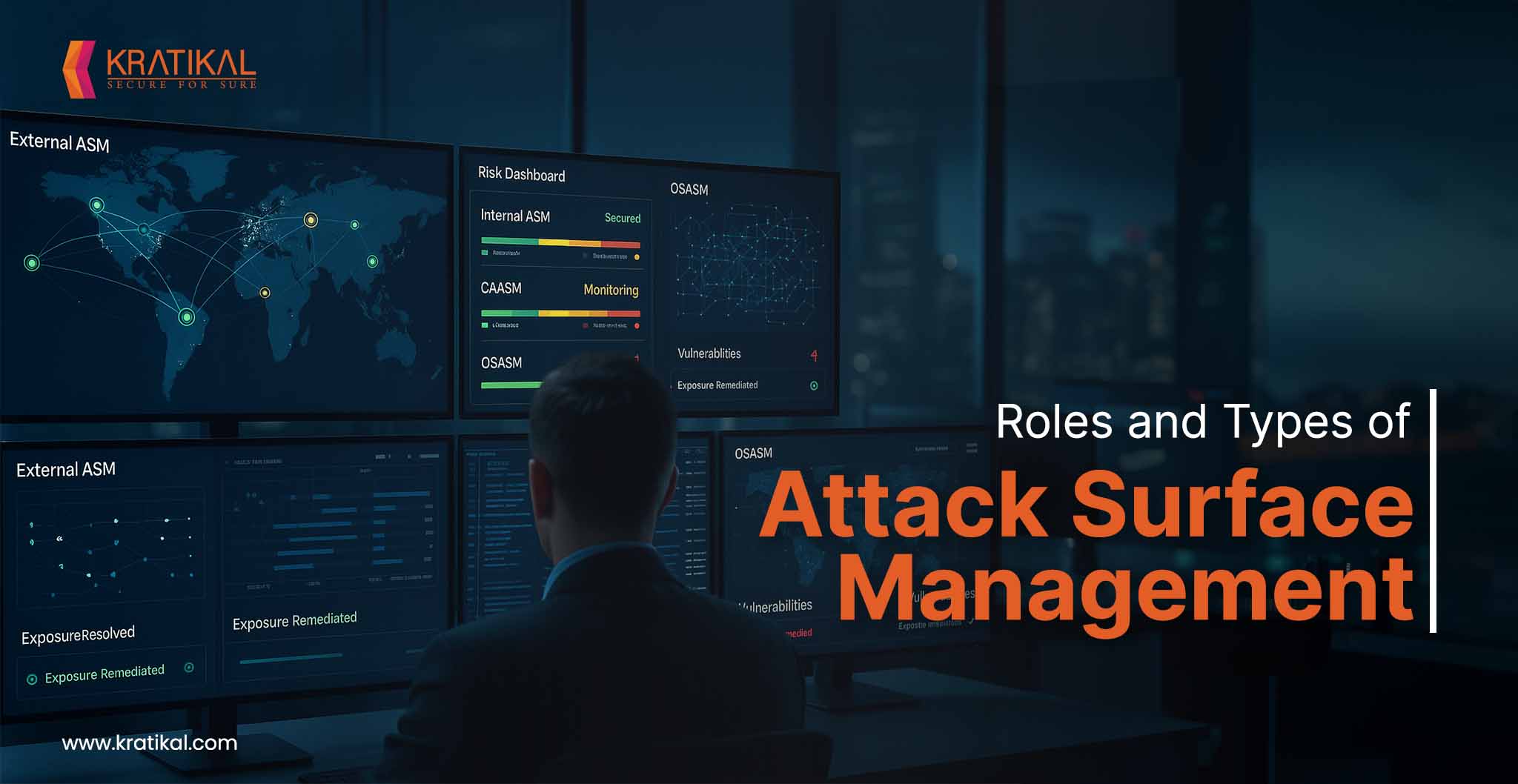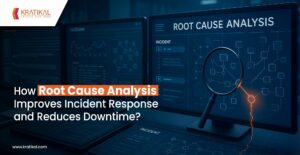Attack Surface Management (ASM) is the continuous process of discovering, analyzing, prioritizing, and remediating cybersecurity vulnerabilities. It also involves monitoring potential attack vectors that make up an organization’s digital attack surface.

Unlike other cybersecurity practices, Attack Surface Management (ASM) is approached from a hacker’s point of view rather than a defender’s. It focuses on identifying potential targets and assessing risks based on the opportunities they offer to malicious attackers.
ASM uses the techniques that hackers rely on. Ethical hackers carry out many of its tasks, using their understanding of hacker behavior to effectively simulate tactics.
Table of Contents
Role of Attack Surface Management
ASM plays a proactive role in strengthening an organization’s overall security posture through five key functions. ASM solutions continuously scan and simulate attacker behavior to uncover vulnerabilities. This approach delivers real-time insights and enables security teams to identify and remediate potential attack vectors before attackers can exploit them in incidents like data breaches or ransomware attacks.
Continous Identification of Assets
An Attack Surface Management (ASM) solution operates from an attacker’s viewpoint, aiming to identify all digital assets and assess their associated cyber risks. Continuous asset discovery plays a crucial role by ensuring security teams maintain visibility into the organization’s entire attack surface.
This process involves systematically scanning and cataloging all connected assets, including on-premise systems like servers and workstations, cloud resources such as instances and storage buckets, web applications, IoT devices, and integrated third-party services.
It ensures a comprehensive and up-to-date inventory that covers not only known and managed assets but also unknown or unauthorized ones—commonly referred to as shadow IT—across on-premise, cloud, and third-party environments.
Risk Assessment
Attack Surface Management involves analyzing the entire asset inventory—both on-site and off-site. It provides context for each asset’s vulnerabilities and their potential severity. This contextual insight includes risk scores and security ratings, taking into account factors such as asset usage, ownership, physical or cloud location, and network connectivity.
Prioritization
Attack Surface Management helps security teams prioritize their response efforts based on thorough risk assessment. It ranks vulnerabilities by evaluating their potential impact and the likelihood of exploitation.
The process begins with analyzing vulnerabilities detected during asset testing. Each is assessed based on its severity, the importance of the affected asset, and possible consequences—such as data breaches or operational disruptions.
Additional factors like remediation complexity and available resources are also considered. This enables a data-driven approach to remediation, allowing teams to strike the right balance between risk severity, exploitation probability, and the effort required to fix the issue.
Remediation
When a potential threat is identified, an attack surface management solution can automatically initiate remediation for high-risk vulnerabilities. The timing of responses to other issues is guided by prioritization analysis based on risk levels.
Remediation actions may include patching outdated systems to prevent exploitation or developing incident response plans to ensure faster and more effective handling of future threats.
Get in!
Join our weekly newsletter and stay updated
Types of Attack Surface Management
ASM encompasses several specialized categories, each targeting different asset types and their unique exposure points. These ASM solutions offer continuous monitoring, identify internal assets and configurations, evaluate security controls, and ensure alignment with security policies—such as access control enforcement. The primary ASM categories include:

External Attack Surface Management (EASM)
External Attack Surface Management (EASM) solutions focus on identifying and evaluating internet-facing assets within an organization’s network environment. These assets include public web servers, APIs, SSL certificates, and cloud services. EASM continuously monitors for changes and analyzes vulnerabilities to provide real-time visibility into the ever-evolving external attack surface.
Common exposures uncovered by EASM include publicly accessible servers, leaked credentials, misconfigured cloud services, data leaks on the deep or dark web, and vulnerabilities in third-party partner software.
Internal Attack Surface Management (IASM)
IASM solutions are designed to identify and mitigate risks within an organization’s internal network. These solutions address challenges such as unauthorized access, privilege misuse, and potential service disruptions. The primary goal of IASM is to minimize threats that originate from inside the organization.
Cyber Asset Attack Surface Management (CAASM)
CAASM focuses on achieving complete visibility into an organization’s entire asset inventory—both internal and external. It integrates the functionalities of Internal ASM (IASM) and External ASM (EASM) to deliver a unified view of the digital ecosystem, encompassing endpoints, servers, devices, and applications.
CAASM aggregates data from internal systems such as asset discovery tools, IT asset management, endpoint protection, vulnerability scanners, and patch management solutions. It also pulls data from external platforms like ticketing systems through API integrations. This comprehensive data enables CAASM to uncover security control gaps and pinpoint vulnerabilities across the environment.
Open Source Attack Surface Management (OSASM)
This specialized area tackles a key concern for CISOs—the risks tied to open-source components, including maintenance challenges, licensing issues, and dependency vulnerabilities. These tools are designed to identify exposed assets, uncover security flaws, and monitor changes that may elevate the risk associated with solutions using open-source elements.
How Attack Surface Management is Used For Better Pentesting?
Attack Surface Management (ASM) serves as a foundational enabler for continuous penetration testing by delivering dynamic, real-time visibility into an organization’s expanding digital footprint. Unlike traditional, point-in-time assessments, ASM provides continuous discovery and monitoring of internet-facing assets—identifying vulnerabilities the moment they surface. Security teams can seamlessly integrate ASM insights into both automated and manual pentesting processes, allowing them to prioritize and address high-risk exposures promptly. By aligning threat detection with real-world attack vectors and asset criticality, ASM transforms penetration testing into an ongoing, intelligence-driven process—enhancing both speed and effectiveness in reducing cyber risk.
Book Your Free Cybersecurity Consultation Today!
Conclusion
Attack Surface Management (ASM) has become a vital component of modern cybersecurity strategy. By continuously discovering and monitoring digital assets from an attacker’s perspective, ASM empowers organizations to proactively identify vulnerabilities, assess risk, and prioritize remediation efforts. Whether it’s through External ASM, Internal ASM, CAASM, or OSASM, these specialized approaches offer deep visibility into potential exposure points across an organization’s entire environment.
When integrated with continuous penetration testing, ASM further enhances threat detection and response, enabling security teams to stay ahead of evolving risks. As digital infrastructures grow more complex and cyber threats more sophisticated, adopting a robust ASM strategy is essential for maintaining strong security posture, minimizing attack vectors, and ensuring long-term resilience.
FAQs
- Why is attack surface management essential?
Attack Surface Management is crucial as it equips security teams with actionable insights and data to maintain a proactive defense posture. It enables them to quickly detect and respond to cyber threats—whether they are known, emerging, or zero-day attacks—with precise and targeted actions.
- How is Attack Surface Management significant for CISOs?
Attack Surface Management is vital for CISOs as it provides a complete view of the organization’s security posture, including unknown assets. This visibility helps prioritize resources, guide remediation efforts, and align security strategies with business goals—enabling proactive defense and greater resilience against cyber threats.








Leave a comment
Your email address will not be published. Required fields are marked *